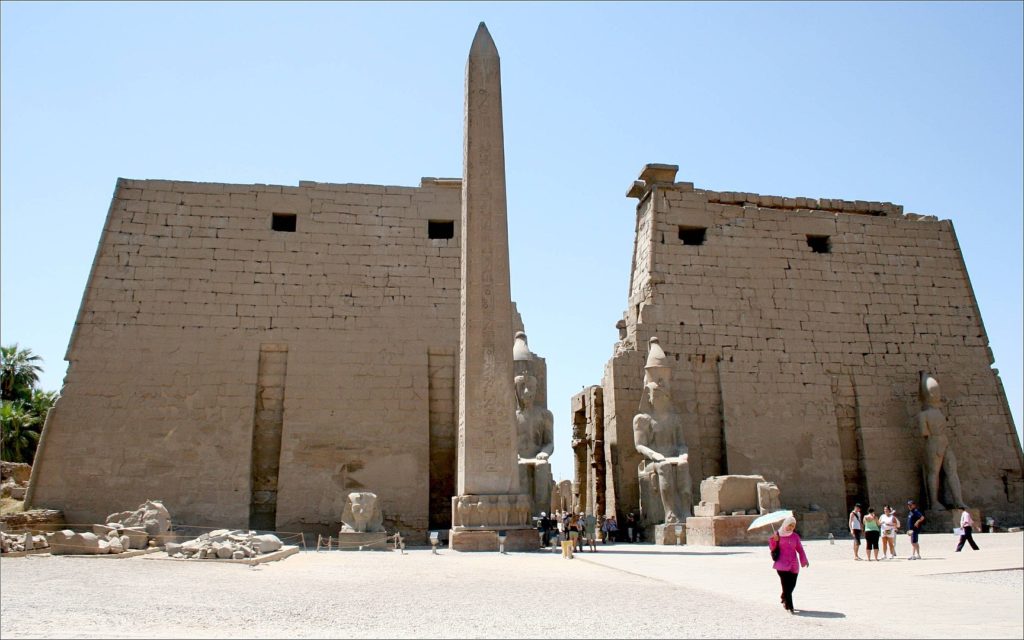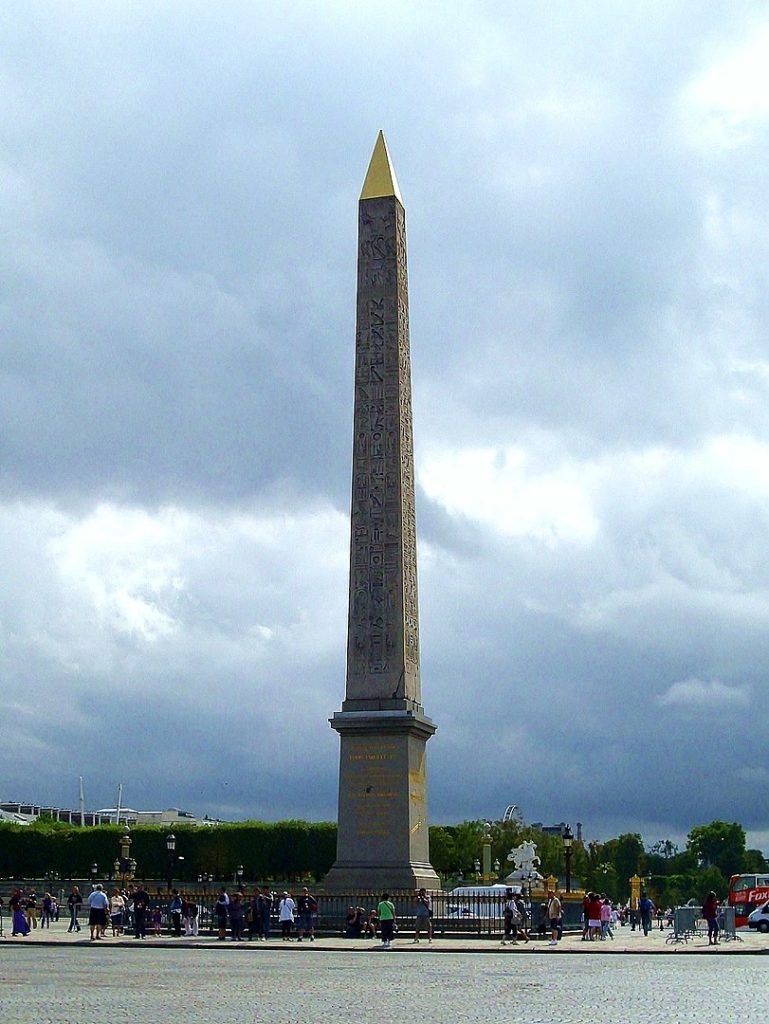
By Glenn Ashton – Wikimedia
Top 10 Facts about the Luxor Obelisk
The Luxor Obelisk in Paris is part of a pair of Ancient Egyptian pillars.
They were carved and stood on either side of the entrance of the Luxor Temple in the reign of Ramesses II.
One of the Pillars can still be found in Egypt, while the other one is in Paris at Place de la Concorde.
This Obelisk is 23 metres tall, 250 tons and was named as a national monument in 1936.
It arrived in France in 1833 and in October of the same year, it was erected in the presence of King Louis Phillipe I and other locals.
The Luxor Obelisk stands above the metro station in Concorde.
It is made of yellow granite with hieroglyphs inscribed on it honouring the Pharaoh Ramesses II.
Let’s look at the top 10 facts about Luxor Obelisk.
1. They Were Built by the Ancient Egyptians
In case you did not know, the Luxor Obelisk standing at Place de la Concorde in Paris was built by Egyptians.
Another Obelisk can be found at the Luxor Temple in Egypt. They had been placed at the entrance of the temple.
The obelisks were associated with the Egyptian Sun god, they represented the rays of light.
The top of the Obelisks would be covered with gold or a mixture of gold and silver alloy, the cover was shaped like the pyramid. This was done to catch the morning light.
There are 28 Obelisks in total. 6 are in Egypt, 1 in Paris while the rest are in different countries around the world.
2. The Luxor Obelisk a gift to King Charles X by the Egyptian Viceroy Mehmet Ali

By Waithamai – Wikimedia
Muhammad Ali is famously known as Mehmet Ali Pesha, who was the first governor of Egypt.
He gifted two obelisks from the Luxor temple to France. This was during his reforms of the Egyptian military, culture and economy of the country.
Jean Baptiste Apollinaire Lebas presented the Obelisks to King Charles X of France.
However, King Louis Philippe was the one who received the Obelisks after he took over the throne.
The Obelisks were shipped by a naval steamer that went to Alexandria, a city in Egypt.
The first Obelisk arrived in the Normandy region of France in August 1833, it reached Paris in December the same year.
3. It took a lot of effort to put up the Luxor Obelisk
Erecting the Luxor Obelisk in Paris was no easy task.
A lot of manpower and expertise was required to ensure it did not get damaged in the process.
They managed to place it on top of a pedestal that details the step by step process of erecting the obelisk.
It also has information on the devices that were used. One of the pulleys that were used to erect the Luxor Obelisk reached its limit and the rope almost broke.
A sailor saved the day by advising that they moisten the hemp ropes since it shrunk when dry.
This Obelisk missed its ‘pyramid crown’ therefore the locals urged the French government to restore it.
The pyramidion was installed years later, in 1997, under the orders of the former French President Jacques Chirac.
4. An Obelisk Was Used in the First Calculation of the Circumference of the Earth

By Glenn Ashton – Wikimedia
One interesting fact about the Luxor Obelisk was that it was used to calculate the circumference of the Earth.
It was around 250 B.C when a Greek Philosopher named Eratosthenes used the Obelisk for this purpose.
At noon during the summer solstice, the Obelisk in the city, modern-day Aswan, would cast no shadow. This was because the sun was directly overhead.
He further observed that at the same time in Alexandria, there was no shadow from the Obelisk as well.
Eratosthenes would then measure the shadow against the tip of the Obelisk.
He concluded that the difference in degrees between Alexandria and Aswan was seven degrees and 14 minutes.
5. The Luxor Obelisk was Made from a Single Piece of Stone
The Luxor Obelisks are made of red granite, they each stand at 22.5 metres and weigh around 227 tonnes.
These Obelisks were carved from a single piece of red granite. It is from this that it got its name, Obelisk meaning monolith in Greek.
The Obelisk in Paris and the one back in the Luxor Temple were the largest. They were erected by Ramses II.
The rest at the temple was erected at the Temple of Heliopolis and Tanis. These monoliths are more than 3000 years old.
One of the Obelisks has the words, without seam, without joining together, inscribed on it. This was done to attribute the tedious work of carving the Obelisk.
6. The Baboons carved at the base of the Obelisk have a meaning

By Olaf Tausch – Wikimedia
The pedestals of the Luxor Obelisks have four carved baboons on them. If you look closely, you will notice that they have raised paws.
In Ancient Egypt, they noticed that the baboons would raise their paws every morning. They concluded that the baboons were adoring the sun.
They saw it befitting on the Obelisks that they built in honour of the sun god.
There are inscriptions with a hymn that tell the significance of the baboons raised paws.
7. The Luxor Obelisk was originally promised to England
Before the obelisks from the Luxor Temple were sent to France, Mehmet Ali Pesha had promised them to England.
A diplomatic negotiation happened between France and Egypt leading to them being gifted.
In exchange for the Obelisks, King Louise Philippe of France gifted Egypt with a large clock.
The clock can be found in the clock tower of the mosque summit of the Citadel of Cairo.
It cost France 2.5 million francs to transport the Obelisks from Egypt to France. The French government built a special ship that had 300 men that helped carry it.
8. The Luxor Obelisk was not easy to build

By Waithamai – Wikimedia
The granite stone is hard, it is said to be second to diamond in hardness.
This means that trying to shape it was even harder. Ancient Egyptians did not use metals to carve the granite.
The metals available at that time were too soft the likes of gold, copper and bronze.
It is therefore believed that the Egyptians used balls of dolerite to shape the obelisks.
Several workers carved the granite using dolerite balls which were no easy task, it required skill and strength.
It remains unclear how the ancient Egyptians moved the granite from the quarry.
9. An Obelisk Helped Archaeologists Translate Hieroglyphics

Photo by Courtney Cook on Unsplash
It was until the 19th century that hieroglyphics were translated before that many believed that it was impossible.
The hieroglyphics are a series of symbols that convey a message, it was the Egyptian form of writing.
This was figured by Jean Francois Champollion who was a French Egyptologist and linguist. He figured out a clue that he used to crack the mysterious code and translated them.
10. The Luxor Obelisk is so old
No archaeologist has figured out how old the Obelisks are. The granites used to carve these Obelisks are believed to be more than 3,300 years old.
One of the first-ever Obelisks to be carved was never finished nor erected. It was abandoned at the quarry in Aswan where similar monuments were carved.
This unfinished Obelisk is 42 metres long and weighs 1,200 tons. It was abandoned after it cracked while being worked on.
Planning a trip to Paris ? Get ready !
These are Amazon’s best-selling travel products that you may need for coming to Paris.
Bookstore
- The best travel book : Rick Steves – Paris 2023 – Learn more here
- Fodor’s Paris 2024 – Learn more here
Travel Gear
- Venture Pal Lightweight Backpack – Learn more here
- Samsonite Winfield 2 28″ Luggage – Learn more here
- Swig Savvy’s Stainless Steel Insulated Water Bottle – Learn more here
Check Amazon’s best-seller list for the most popular travel accessories. We sometimes read this list just to find out what new travel products people are buying.










